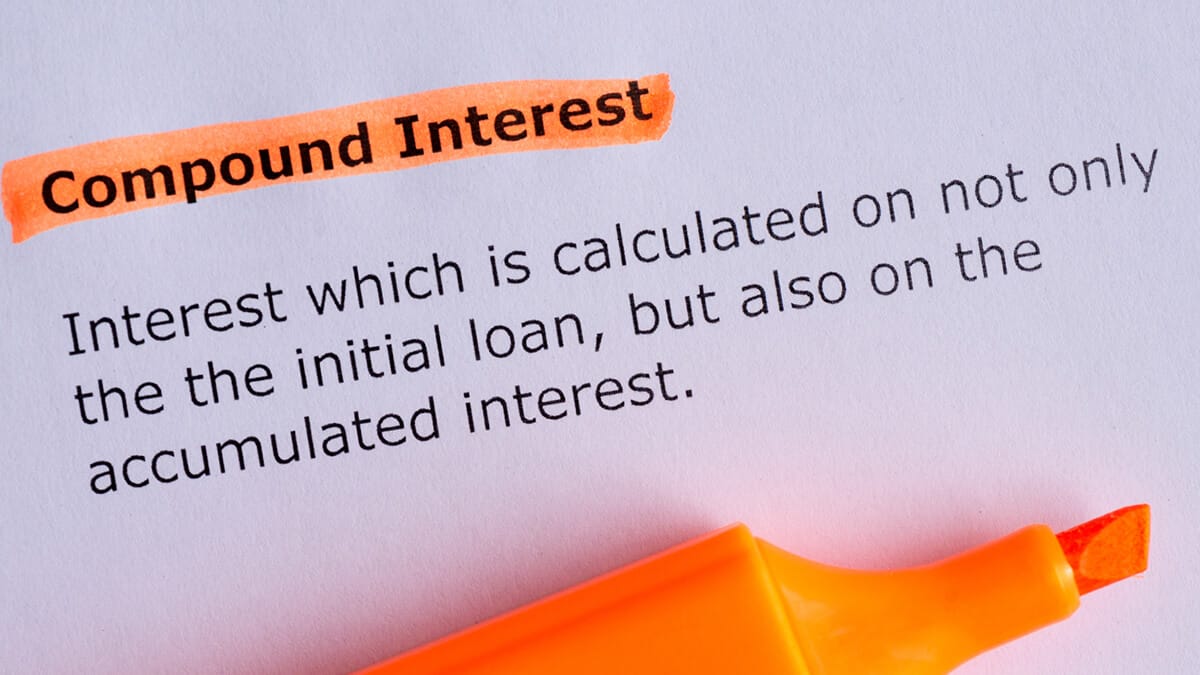In this guide
Compound interest is the eighth wonder of the world.
He who understands it, earns it.
He who doesn’t, pays it.
Albert Einstein isn’t the only bright spark to recognise the power of compound interest.
Legendary investor Warren Buffett called his biography The Snowball in reference to the snowball effect. He started investing as a teen and that snowball is still rolling and growing exponentially. Now in his 90s, after a lifetime of buying quality investments and holding them for the long term, his net worth is over US$116 billion.
By understanding the basic principle of compound interest, especially early in your working life, you too can grow modest, regular savings into a substantial nest egg. You may not end up on the rich list, but you can still enjoy a comfortable standard of living in retirement.
That’s the simple concept behind superannuation, but compound interest is not simple.
Compound interest vs simple interest
When you are earning compound interest on an investment, it means you not only receive interest on the principal invested, but you also receive interest on your interest plus principal. That’s why compound interest is often referred to as ‘interest on interest’ and it will grow a lump sum faster than simple interest.
We look at compound interest and how it applies to your super in the future, but first, it’s important to understand how compound interest differs from simple interest.
Simple interest is generally paid in one hit at the end of a specified period. Term deposits are a good example. Say you invest $10,000 in a one-year term deposit at 5% interest; at the end of the term, you receive $500 plus your initial investment of $10,000 for a total of $10,500.
Now say you roll over your initial $10,000 investment each year for ten years at 5%. Each year you earn $500 in interest, which you spend, while reinvesting your original $10,000. After ten years, you’ll have earned a total of $5,000 in interest (10 x $500), giving you a total investment value of $15,000.
That’s simple interest. However, you can turn simple interest into compound interest by reinvesting the interest you receive each year.
The table below shows what happens to your $10,000 investment if you resist the temptation to spend your annual interest payments and reinvest them instead. After ten years, you will earn a total of $6,289 in interest for a total investment value of $16,289.
| Year | Start balance | Interest | End balance |
|---|---|---|---|
| 1 | $10,000 | $500 | $10,500 |
| 2 | $10,500 | $525 | $11,025 |
| 3 | $11,025 | $551.25 | $11,576.25 |
| 4 | $11,576.25 | $578.81 | $12,155.06 |
| 5 | $12,155.06 | $607.75 | $12,762.81 |
| 6 | $12,762.81 | $638.14 | $13,400.95 |
| 7 | $13,400.95 | $670.05 | $14,071.00 |
| 8 | $14,071.00 | $703.55 | $14,774.55 |
| 9 | $14,774.55 | $738.73 | $15,513.28 |
| 10 | $15,513.28 | $775.66 | $16,288.94 |
| Total | $6,288.94 | $16,288.94 |
It might not seem like much difference, but the compound interest you earn on a $10,000 investment over ten years results in a balance that’s almost 9% higher than you would achieve earning simple interest ($16,289 vs $15,000).
2026 SMSF calendar
Our free calendar includes due dates for important documents plus suggested dates for trustee meetings and other strategic issues for your SMSF.
"*" indicates required fields
It’s also important to note that the amount of compound interest accrued will be affected not just by the amount of interest paid out, but also the frequency of the payments. So, if 5% interest is accrued monthly on $10,000, the balance will be higher than if 5% interest is accrued annually.
You can do your own sums using one of the many compound interest calculators available online. We’ve used Moneysmart’s compound interest calculator. Alternatively, see the Rule of 72 below for a simple calculation of how long it will take an investment to double in value at a given rate of compound interest.
Using the Rule of 72 to help you choose an investment
The Rule of 72 is a quick way to estimate the number of years required to double your money at a given annual compound rate of return. It can also help you calculate what effect fees and inflation can have on your investment.
The calculation goes like this: years to double your investment = 72 divided by your expected annual rate of return.
Say you are tossing up whether to put a windfall into a high-interest savings account paying interest of 3% a year or shares with an estimated annual return of 8% a year from a combination of dividends (reinvested) and capital appreciation.
As you can see in the table below, in a high-interest savings account that pays around 3%, annual compounded returns will take 24 years to double in value (72/3). Whereas shares with a compound rate of return of 8% a year will take just nine years to double in value (72/8).
Super knowledge is a super power

"*" indicates required fields
| Annual return | Number of years to double |
|---|---|
| 1% | 72 |
| 2% | 36 |
| 3% | 24 |
| 4% | 18 |
| 5% | 14.4 |
| 6% | 12 |
| 7% | 10.3 |
| 8% | 9 |
| 9% | 8 |
| 10% | 7.2 |
| 11% | 6.5 |
| 12% | 6 |
| 13% | 5.5 |
| 14% | 5.1 |
| 15% | 4.8 |
| 16% | 4.5 |
| 17% | 4.2 |
| 18% | 4 |
| 19% | 3.8 |
| 20% | 3.6 |
Of course, the actual rate of return will depend on how long your money is invested, market conditions, taxes, fees and how much risk you are prepared to accept. But that’s too much information if you just want to mentally map out your options.
Another benefit of the Rule of 72 is that you can turn the equation around and work out the annual interest rate needed to double your investment over a given period.
Say you want to double your investment in four years; then you will need to earn an annual interest rate of 18% (72/4). A more realistic expectation might be to double your investment in a decade (72/10), which would require an annual interest rate of 7.2%.
| Desired years to double investment | Annual interest rate needed is |
|---|---|
| 1 | 72% |
| 2 | 36% |
| 3 | 24% |
| 4 | 18% |
| 5 | 14.4% |
| 6 | 12% |
| 7 | 10.29% |
| 8 | 9% |
| 9 | 8% |
| 10 | 7.2% |
| 11 | 6.55% |
| 12 | 6% |
| 13 | 5.54% |
| 14 | 5.14% |
| 15 | 4.8% |
| 16 | 4.5% |
| 17 | 4.24% |
| 18 | 4% |
| 19 | 3.79% |
| 20 | 3.6% |
It’s important to remember that the Rule of 72 applies to investments that pay compound interest, not simple interest. In fact, it can be used on anything that grows at a compounded rate, such as population, macroeconomic numbers, charges, loans or fees that eat into investment gains.
This means:
If GDP grows at 3% annually, the economy will be expected to double in 24 years (72/3). Conversely, a managed fund that charges 3% in annual fees will reduce the investment principal to half in around 24 years.
A borrower who pays 15% interest on a credit card or any other form of loan charging compound interest will double the amount they owe in just 4.8 years (72/15).
If inflation is 6%, then a given purchasing power of the money will be worth half in around 12 years (72/6). If inflation decreases from 6% to 4%, an investment will be expected to lose half its value in 18 years (72/4), instead of 12 years. And so on.
There are more complex calculations for working out how long it takes to double an investment value, but the Rule of 72 is convenient and produces an answer close to the exact algorithmic value.
Now that we know an investment growing at a compound rate of 7% a year will roughly double in value every ten years, imagine how your money will grow over 40 years or more. That’s the simple but powerful concept behind super.
The power of compound interest for your super
The secret to investment success is the combination of compounding returns plus time. Australia’s superannuation system took this simple truth and ran with it.
Super is designed to lock away ongoing contributions made by you and/or your employer plus all investment earnings for 30 years or more until you retire. And it doesn’t end there. If you transfer your retirement balance into a super pension account, your investments continue to earn and grow throughout your retirement years.

Free eBook
Retirement planning for beginners
Our easy-to-follow guide walks you through the fundamentals, giving you the confidence to start your own retirement plans.
"*" indicates required fields
Most super fund members are invested in a mix of assets such as shares, property, infrastructure, cash and bonds, which all yield varying rates of return. For example, Growth super funds, where most Australians have their retirement savings, typically have between 61% and 80% in growth assets such as shares and the remainder in defensive assets such as cash and bonds.
While there will be negative years, Growth funds typically set a target of no more than one negative year in five. Over the past 15 years to June 2025, the median Growth fund has returned 8% per year after fees and tax.
Over time, your contributions and rate of return may stay relatively steady, but the interest on the interest (or returns on the returns) grow exponentially thanks to the compounding effect.
To illustrate this, below is a simple example showing the potential retirement outcome for someone entering the workforce today.
As you can see, even small additional contributions to super can make a big difference to your retirement outcome, thanks to the magic of compound interest. The sooner you start, the more powerful the effect and the more money you will have to play with when you retire.

Leave a Reply
You must be logged in to post a comment.